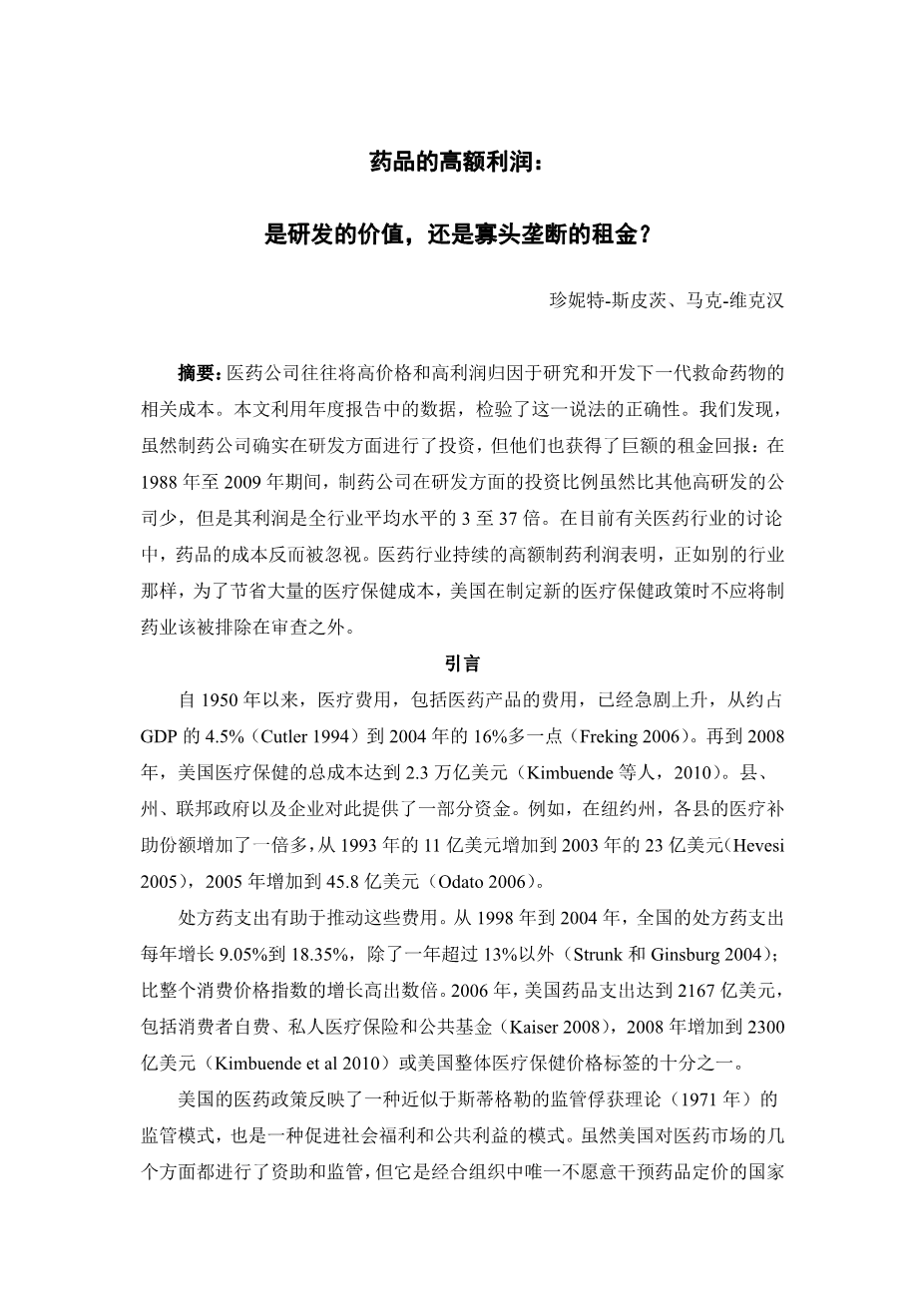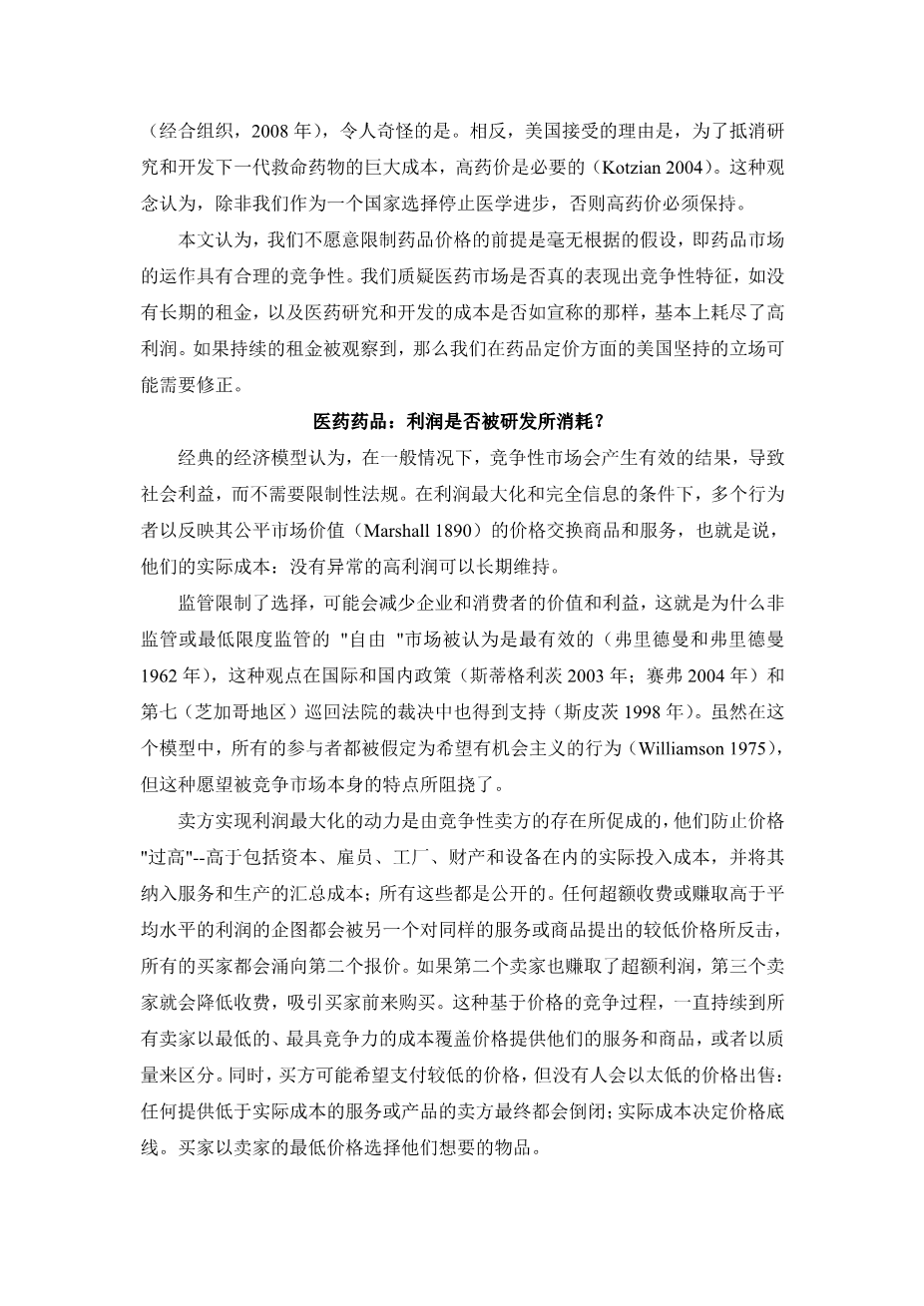Pharmaceutical High Profits:
The Value of Ramp;D, or Oligopolistic Rents?
By JANET SPITZ and MARK WICKHAM
ABSTRACT. Pharmaceutical firms attribute high prices and high profits to costs associated with researching and developing the next genera- tion of life-saving drugs. Using data from annual reports, this article tests the validity of this claim. We find that while pharmaceutical firms do invest in Ramp;D, they also enjoy strong rents; between 1988 and 2009, pharmaceuticals enjoyed profits of 3 to 37 times the all-industry average, depending on the years, while investing proportionately less in Ramp;D than other high-Ramp;D firms. Costs of pharmaceutical drugs have successfully flown below the radar in much of the current health care debate, with producers managing to obstruct alternative sourcing as well as payment cuts. While health care is examined for savings in other areas, sustained high pharmaceutical profits suggest that as a new health care policy develops in the U.S., the pharma- ceutical industry should not be excluded from examination for sig- nificant savings in health care costs.
Introduction
Health care costs, including the cost of pharmaceutical products, have risen dramatically since 1950, from about 4.5 percent of GDP (Cutler 1994) to a little over 16 percent in 2004 (Freking 2006); this includes 1 of every 4 budgeted federal dollars; which is around $0.7 trillion (Hutcheson 2006). By 2008, the total cost for health care in the U.S. reached $2.3 trillion (Kimbuende et al. 2010). County, state, and federal governments, along with business, provide a portion of thesefunds. In New York State, for example, countiesrsquo; share of Medicaid more than doubled from $1.1 billion in 1993 to $2.3 billion in 2003 (Hevesi 2005), increasing to $4.58 billion in 2005 (Odato 2006).
Prescription drug spending helps drive these costs. National spend- ing on prescription drugs increased between 9.05 percent and 18.35 percent each year from 1998 to 2004, with all but one year above 13 percent (Strunk and Ginsburg 2004); several times more than the increase in the overall consumer price index. U.S. pharmaceutical spending reached $216.7 billion in 2006 including consumer out-of- pocket, private health insurance, and public funds (Kaiser 2008), increasing to $230 billion in 2008 (Kimbuende et al 2010) or one-tenth the price tag for U.S. health care overall.Despite this 10 percent contribution of drugs to health care costs,U.S.pharmaceutical policy reflects a regulatory pattern that approxi- mates Stiglerrsquo;s theory of regulatory capture (1971) as much as one that promotes social welfare and the public good. While the U.S. both funds and regulates several aspects of pharmaceutical markets, it is the only country among the OECD that is curiously reluctant to interfere in pharmaceutical pricing (OECD 2008). Instead, the U.S. accepts the rationale that high drug prices are necessary to offset the extraordinary cost of researching and developing the next generation of life-saving drugs (Kotzian 2004). The notion is that unless we as a nation choose to halt medical progress, high drug prices must remain.
This article suggests that our reluctance to limit pharmaceutical pricing is predicated on the unwarranted assumption that pharma- ceutical markets operate reasonably competitively. We question whether pharmaceutical markets indeed exhibit competitive charac- teristics such as the absence of longer term rents, and whether costs of pharmaceutical research and development largely use up high profits as claimed. If sustained rents are observed, then our U.S. hold-out position with respect to pharmaceutical pricing might require amendment.
Pharmaceutical Drugs: Are Profits Consumed by Ramp;D?
Classic economic models hold, in the general case, that competitive markets generate efficient outcomes, leading to societal benefitwithout constraining regulations. Under conditions of profit maximi- zation and complete information, multiple actors exchange goods and services at prices that reflect their fair market value (Marshall 1890), which is to say their actual costs: no unusually high profits may be sustained over time.
Regulation restricts options, potentially decreasing value and benefits for firms and consumers, which is why non- or minimally- regulated “free” markets are suggested to work best (Friedman and Friedman 1962), a view sustained in international and domestic policy (Stiglitz 2003; Cypher 2004) and in 7th (Chicago area) Circuit Court decisions as well (Spitz 1998). While all players are assumed to want to behave opportunistically in this model (Williamson 1975), that desire is thwarted by characteristics of the competitive market itself.
Sellersrsquo; drive to maximize profit is mediated by the presence of competing sellers who prevent prices that are “too high”—higher than the actual cost of inputs including capital, employees, plant, property, and equipment, rolled into the summary costs of service and production; all of these are openly known. Any attempt to overcharge or make above-average profit is countered by anotherrsquo;s somewhat lower price offered for the same service or good, whereupon all buyers flock to the second offer. If that second seller also makes excess profit, a third charges less, drawing buyers there. This process of competition on the basis of price, continues until all sellers offer their services and goods at the lowest, most competitive cost-covering price, or are otherwise differentiated by quality.
At the same time, buyers presumably wish to underpay, but no one will sell at that too-low price: any seller offering services or products below actual cost will eventually go out of business; real costs determine price floors. Buyers choose the items they want at the sellersrsquo; lowest possible price.
剩余内容已隐藏,支付完成后下载完整资料


英语译文共 12 页,剩余内容已隐藏,支付完成后下载完整资料
资料编号:[589248],资料为PDF文档或Word文档,PDF文档可免费转换为Word


